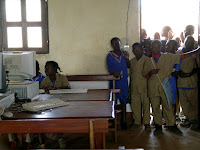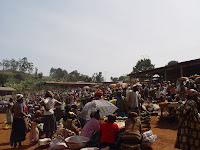Three reports from your EWB representatives as we wrap up this second trip to Cameroon:
-------------------------------------------------------
If anyone has been trying to follow the itinerary of our trip, then you will have quickly realized that we had to depart from it on many occasions. This trip has given us the opportunity to meet with many new people whose perspectives will surely help us make the best decisions possible. For an issue as important as potable water, we have learned not both sides to it, but at least a half dozen different viewpoints for the same goal. This trip has had its ups and downs, but for every failure we have seen, there have been clearly many more successful solutions in place.On Thursday we had finished talking with nearly everyone we had set out to contact. We decided to continue hiking through some of Bakang’s still unknown areas and discovered two new wells. The women who used them told us the familiar story that the wells were not used for drinking water. After taking pictures together with our digital cameras, I asked to take one more of them with my Polaroid. Giving them the slowly developing picture, it was a priceless moment to see their reaction when they realized they were looking at themselves. We could not understand what they were saying but they were very excited.
Our translator (Kom) teaches English at a local high school in Bamendjou and conversations with him turned to the teachers and facilities available there. Cameroon’s schools lack

the number of teachers needed and the high school has about half as many as it needs. Kom and the local PCV Nura also teach basic computer skills to the students, but a computer lab full of 40 students must share between four well used computers. Nura has tried to use paper keyboards to teach the students but what they need are more computers. Compared to a potable water system, bringing several old computers by American standards to the high school seems to be a small challenge.
We also visited the church again to learn about their brick making abilities. It turns out that they do not make bricks in an oven, but instead use concrete and molds to make anything they need. It is part of an educational program to teach the technical aspects of the process and they were open to helping us make anything we could need in the future. We had one last meeting with the chief and he answered many of our concerns that had developed over the trip. He is a knowledgeable person and understands the requirements to keep a water system sustainable after we no longer come back to Bakang.
After several last things to do in Yaoundé, we will shortly be heading home. This trip has been a great cultural experience and I look forward to sharing our adventures with everyone soon.
Doug
----------------------------------
We are coming to the end of our trip and it feels like we just got here. It is going to be such a drastic change to go from living in the village community where life just happens when it happens to a world where time and money tend to be the driving factors. Over breakfast this morning, I said how I feel like this is one of the first times in a long time where I have been truly relaxed, even though we have been constantly doing things. I have been thinking about the transition back into life at UD and I don’t feel that I will be ashamed for what I have, but rather grateful that I have the opportunities and the amenities to take advantage of these opportunities. It will be different though, not having every single person say “Bonjour” to you as you walk down the street. Life in this village is not easy, by our standards, but it is good. I am looking forward to sharing all of the experiences that I have had over these past few weeks with everyone and reflecting on the entire adventure.
We went to the “marché” yesterday which is the market in the village of Bamendjou. The traditional schedule includes an eight day week so the marché changes every week. There were countless numbers of tables every time you turned another corner. Everyone from the

region was at the marché buying pretty much everything. There are regions where specific types of tables are set like the bakery section, the fresh produce, the fabric for dresses, the live animal section and various other sections. I was able to purchase the most wonderful piece of traditional art. It is a long stick that is beaded on one end with horse hair on the other end (slightly ignoring the vegetarian thing). This stick is given to the heads of families, a male, and used during various ceremonies to lead the family members in the traditional dances. All the various males used them at the funeral we went to over the weekend. Doug bought a traditional shirt with a beautiful pattern and Dr. Steve bought a blanket in this same pattern. While at the marché, it is expected that you will barter for your purchases. When the initial prices are given, they are so low that my face tends to ruin any ability to barter for a lower price. We were able to get a few things down though. We looked to buy an avocado (so fresh and wonderful) and they expected us to pay 10 cents! We got it down to 5 cents, but still felt that we were getting ripped off. People are constantly running up to you trying to get you to buy from their table. We tended to make big purchases at only a few tables and after thought we should have spread out our spending to more tables. The one thing that got to me was seeing a pig, still alive, strapped to the back of a motorcycle being taken home. The marché is such a big deal that the local beer company, “33”, sent a truck to the center of town that had a live band for the people to listen to. They weren’t that good, but it was fun to see.
We are heading back to Yaoundé for the last night. We are planning on having dinner with a friend of Olivia, one of our contacts, and running a few last minute errands. Then it is to Paris and Philadelphia!
-Amelia
--------------------
We left the Bamiléké highlands today, for the capital city of Yaoundé and then home. This was my second trip and I expect several more, but still, leaving was with a touch of remorse. The people here expect so much of us and I hope we will live up to their expectations.
Of course, I will never know life here as they know it. But I have learned more of their traditions and the pride they have in their long history as a people. While keeping their traditions, they are ready for the changes that will bring them better health and a more prosperous life. Education is taken seriously in spite of the pitiable lack of resources in the schools. In the larger cities we have met an educated class that struggles with how to lift the standard of living for their population. I have heard many Cameroonians repeat a popular slogan that “nous sommes ensembles” – “we are together.” I reflect on the fact that, of the many hand-dug wells we surveyed in Bakang, not one was over 25 years old. This means that the most people grew up with their only water source being the streams. Change is accepted, but gradually.
The red dust blows in the dry winds, coating the igneous rocks from which it came. The dirt road takes us along valleys sprinkled with the traditional steep roofs now made of corrugated metal. The population density is high, so even the generous earth is hard pressed to provide for the people. We’ve eaten sumptuously, but primarily of the mainstay foods—plantains, greens, carrots, potatoes, corn—that provide a marginal level of protein. Electricity and potable water are luxuries and simply unavailable in more remote areas such as Bakang.
Word travels fast here without the need for electronics. Everyone who sees us on the roads and footpaths of Bakang knows who we are and what we’re working on. As we’ve passed people, one of the greetings we’ve heard is “bon courage.” They seem to know that we do not have an easy task. But none of them understand that we do not have the financial resources that we need—so far, at least—to engineer and construct their water system. We come from America, the land of wealth and generosity. The most educated of them imagine that we can write a note to Bill Gates for the funding we need. But, of course, it’s much more difficult than this.
I did not know that Engineers Without Borders would place us in this dilemma. As we fly out of Africa tomorrow, I will be wondering: Are we really “together?”
Dr. Steve
 the number of teachers needed and the high school has about half as many as it needs. Kom and the local PCV Nura also teach basic computer skills to the students, but a computer lab full of 40 students must share between four well used computers. Nura has tried to use paper keyboards to teach the students but what they need are more computers. Compared to a potable water system, bringing several old computers by American standards to the high school seems to be a small challenge.
the number of teachers needed and the high school has about half as many as it needs. Kom and the local PCV Nura also teach basic computer skills to the students, but a computer lab full of 40 students must share between four well used computers. Nura has tried to use paper keyboards to teach the students but what they need are more computers. Compared to a potable water system, bringing several old computers by American standards to the high school seems to be a small challenge.